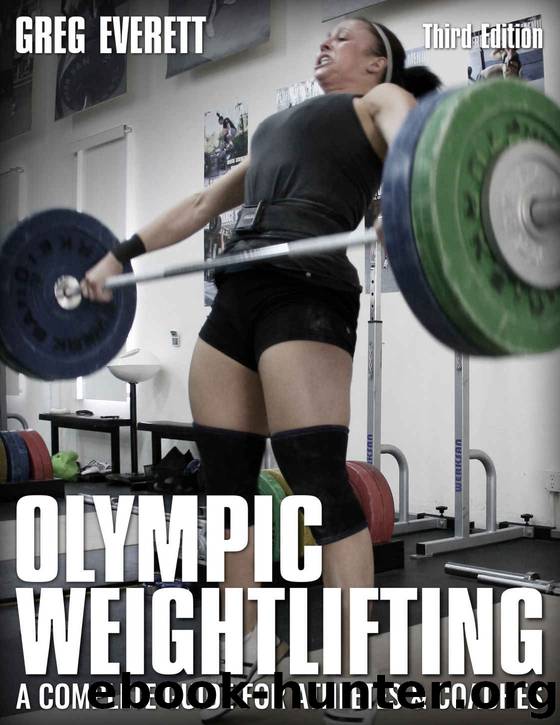Olympic Weightlifting: A Complete Guide for Athletes & Coaches by Everett Greg

Author:Everett, Greg [Everett, Greg]
Language: eng
Format: epub
Publisher: Catalyst Athletics
Published: 2016-01-21T05:00:00+00:00
Interset Rest Periods
Rest periods between sets should primarily reflect the intention of the exercise in that given training session, but can also be manipulated to somewhat alter the training effect of the same exercise, intensity, sets and reps.
For weightlifting, interset rest can typically be ad libitum—whatever the lifter feels is appropriate—as most will naturally rest according to need. If a certain lifter proves to exercise poor judgment with regard to rest periods (most commonly, resting too long), rest times can be prescribed.
Recuperation between sets involves two components: the replenishment of ATP (the molecule that directly provides energy for muscular contraction) in the muscles and the refreshing of the nervous system. Following a set, approximately 50-70% of ATP levels are restored within 20-30 seconds, and 100% in approximately 3 minutes (Bompa 1999). However, CNS recovery can take considerably longer depending on the nature of the exercise and the intensity. When training primarily for neurological adaptations (absolute, speed and explosive strength, as well as technical mastery), as is done with weightlifting, neurological freshness for each set is typically desirable, requiring somewhat longer rest periods generally; this does not mean genuinely complete recovery between all sets, which is usually impossible in a practical sense, but maximizing freshness within the constraints of a given training session.
In general, the higher the technical complexity, higher the intensity, and lower the reps, the longer the rest period necessary for an exercise. For such lifts, rest times of 3-5 minutes are advisable. For lower intensity, lower complexity, higher-rep lifts, rest times of 2-3 minutes may be adequate. Moderately technical but very taxing lift sets (such as very difficult sets of 3-6 reps in the squat) will typically demand relatively long rest periods due to a combination of CNS and ATP restoration needs. Absolute maximum single-rep lifts can require as much as 10-15 minutes of rest for complete recovery (Zatsiorksy 1995); however, genuine maximal lifts will very rarely be performed in the gym, and when they are, they will likely not be followed by subsequent sets of the same exercise at the same intensity.
Beginning lifters will require less interset rest than advanced lifters with any combination of exercise, intensity and repetitions due to their lower neurological development and consequent inability to perform truly neuromuscularly demanding work.
Competition Preparation In competition mesocycles, it often makes sense to limit interset rest to 2 minutes between snatch and clean & jerk sets to condition lifters both physically and mentally for the sometimes quick pacing of competition. This may be done throughout the entire mesocycle, or limited to certain training days.
On The Minute Sets A notable exception to the rule of longer interset rest between high complexity lifts is the on-the-minute protocol for the snatch, clean, jerk and clean & jerk. This protocol was popularized in the US by coach Joe Mills with his 20/20 program.
The primary benefit to training the competition lifts on the minute is the technical consistency it nearly always creates. This is largely due to the inability of the lifter
Download
This site does not store any files on its server. We only index and link to content provided by other sites. Please contact the content providers to delete copyright contents if any and email us, we'll remove relevant links or contents immediately.
Periodization Training for Sports by Tudor Bompa(8174)
Bodyweight Strength Training by Jay Cardiello(7844)
Born to Run: by Christopher McDougall(7066)
Inner Engineering: A Yogi's Guide to Joy by Sadhguru(6728)
Asking the Right Questions: A Guide to Critical Thinking by M. Neil Browne & Stuart M. Keeley(5657)
The Fat Loss Plan by Joe Wicks(4851)
Bodyweight Strength Training Anatomy by Bret Contreras(4614)
Yoga Anatomy by Kaminoff Leslie(4310)
Dynamic Alignment Through Imagery by Eric Franklin(4123)
Science and Development of Muscle Hypertrophy by Brad Schoenfeld(4089)
ACSM's Complete Guide to Fitness & Health by ACSM(3991)
Exercise Technique Manual for Resistance Training by National Strength & Conditioning Association(3963)
The Four-Pack Revolution by Chael Sonnen & Ryan Parsons(3933)
Bodyweight Strength Training: 12 Weeks to Build Muscle and Burn Fat by Jay Cardiello(3919)
The Ultimate Bodybuilding Cookbook by Kendall Lou Schmidt(3886)
Yoga Anatomy by Leslie Kaminoff & Amy Matthews(3867)
American Kingpin by Nick Bilton(3761)
Nutrition for Sport, Exercise, and Health by Spano Marie & Kruskall Laura & Thomas D. Travis(3715)
Yoga Therapy by Mark Stephens(3705)
